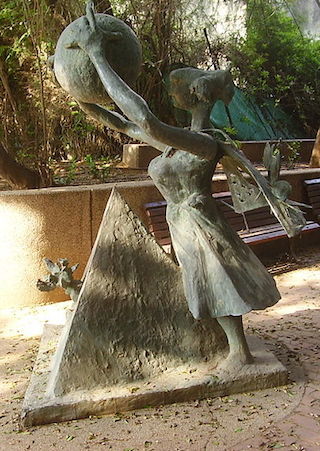The Largest Sphere Within A Pyramid
 is a convex quadrilateral such that
,
and
.
is a point in space such that
and the volume of the pyramid
is equal to
.
is a convex quadrilateral such that
,
and
.
is a point in space such that
and the volume of the pyramid
is equal to
.
The surface area of the largest ball that can fit inside such a pyramid can be expressed as where are positive integers, with the smallest possible. What is
Image credit: Wikipedia Avishai Teicher
The answer is 54.
This section requires Javascript.
You are seeing this because something didn't load right. We suggest you, (a) try
refreshing the page, (b) enabling javascript if it is disabled on your browser and,
finally, (c)
loading the
non-javascript version of this page
. We're sorry about the hassle.
First of all, ∣ A S ∣ ⋅ ∣ D S ∣ ≤ 2 1 by the Arithmetic-Geometric Mean Inequality. At the same time, [ A S D ] = 2 1 sin ∠ A D S ⋅ ( ∣ A S ∣ ⋅ ∣ D S ∣ ) . So [ A S D ] ≤ 4 1 . Because B D divides the area of A B C D in half, the volume of A B D S is exactly half of the volume of the pyramid, so it equals 1 2 1 . On the other hand, consider A B D S as a pyramid with base A S D . Its volume is 3 1 ⋅ [ A S D ] ⋅ ∣ A B ∣ sin α , where α is the angle between A B and the plane A S D . Since ∣ A B ∣ = 1 , all these inequalities must be equalities! Thus, A B ⊥ A S D , ∣ A S ∣ = ∣ D S ∣ , and ∠ A S D = 9 0 ∘ .
By the Pythagorean theorem, ∣ A D ∣ = 1 , so A B D is an isosceles right triangle. Since ∣ B C ∣ = ∣ C D ∣ and [ B C D ] = [ B A D ] , A B C D is a square, with side 1 . Because A B ⊥ A S D , the planes A B C D and A S D are perpendicular. If E is the midpoint of A D and F is the midpoint of B C , then ∠ F E S = 9 0 ∘ , ∣ E F ∣ = 1 , ∣ E S ∣ = 2 1 .
Note that the given conditions define the pyramid uniquely, we just need to find the largest radius of a ball that fits in it. Consider the infinite cylinder with the perpendicular cross-section F E S . Clearly, any ball that fits inside A B C D S will fit inside this cylinder. The largest possible radius of a ball inside this prism cannot be larger than the in-radius of the triangle F E S .
Lemma. The in-radius of a right triangle U V W , with the right angle V , equals ∣ U V ∣ + ∣ V W ∣ + ∣ U W ∣ ∣ U V ∣ ⋅ ∣ V W ∣ .
Proof. If the in-radius is r , then 2 1 ∣ U V ∣ ⋅ ∣ V W ∣ = [ U V W ] = r ⋅ 2 ∣ U V ∣ + ∣ V W ∣ + ∣ U W ∣ and the formula easily follows.
From the above lemma, the in-radius of A S D equals 2 1 / ( 1 + 2 ) = 2 + 2 2 1 . Similarly, the in-radius of the triangle F E S is ( 2 1 ) / ( 2 5 + 2 1 + 1 ) = 3 + 5 1 One can easily check that 2 + 2 2 < 3 + 5 , so the in-radius of A S D is greater than the in-radius of F E S . Clearly, the largest radius of a ball inside A B C D S is no larger than 3 + 5 1 . On the other hand, place a ball of this radius in the in-center of F E S . Because the distance from this in-center to E F is 3 + 5 1 , the distance from it to the planes A B S and D S C equals 2 2 1 − 2 1 ⋅ 3 + 5 1 = 2 2 ( 3 + 5 ) 5 + 1
One can easily check that 5 + 1 > 2 2 , so this distance is greater than the in-radius of F E S , thus the ball fits! So the largest possible radius is r = 3 + 5 1 = 4 3 − 5 . The surface area is 4 π r 2 = 4 1 4 − 6 5 π = 2 7 − 4 5 π . So ( a , b , c ) = ( 7 , 4 5 , 2 ) , thus a + b + c = 5 4 .